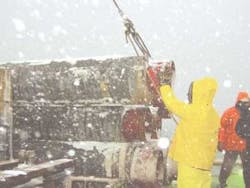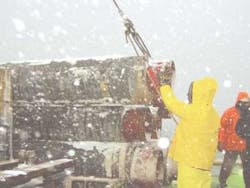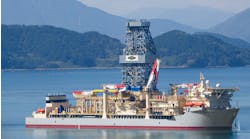William Furlow Houston
Iroquois project faced ice, rock off Long Island
With a strong presence in the Gulf of Mexico, Horizon Offshore decided to step outside its conventional areas of operation and take on an inland pipelay job off the coast of Long Island, New York.
The Iroquois project is a 34-mi-long, 24-in. gas transport line that crosses Long Island Sound carrying production to the city of New York. The line replaces 40-year-old infrastructure and follows a route near environmentally-sensitive shellfish beds. The sensitivity of the seabed was a factor in the choice of pipeline burial methods and anchor placement. Because this job is so close to shore, it involved trenching operations in areas with contaminated soil. It also took place during one of the coldest winter of the last 30 years.
George Reuter, vice-president at Hor-izon and director of the Iroquois East-chester Extension Pipeline Project, said the effort to win the work began in Dec-ember 2000, when the company launched a prequalification and bidding campaign that lasted 18 months and included four tender requests. Horizon was awarded the project in April 2002.
The Iroquois project called for laying and burying a gas pipeline from Northport, Long Island, extending southwest down the Long Island Sound and into the East River, reaching landfall in the South Bronx at Hunt's Point. Water depth ranges from landfall to 120 ft. The Gulf Horizon pipelay barge performed the trenching and pipelay work. It was supported by a dedicated ROV/diving vessel, crew boat, anchor handling tugs, and pipe-haul barges.
Before mobilizing to Long Island, the Gulf Horizon underwent extensive refurbishments and was upgraded for this job. A 150-ton A-frame was installed on the vessel's stern to handle a specially constructed plow needed for the job. Additional mooring winches were also installed. The firing line had to be enclosed to protect personnel and the automatic welding equipment from the elements. Reuter said it was an unusual experience for much of the vessel's crew, accustomed to operating in the balmy conditions of the Gulf of Mexico, to be stomping through foot-deep snowdrifts on the deck.
Not only were the frigid conditions hard on the crew, they affected the equipment as well. Reuter said hydraulic fluids and other equipment such as automatic welding units work best in above-freezing temperatures. The pipe joints collected ice both inside and out, requiring some creative solutions, Reuter said. Oxyacetylene torches were mounted on rolling skids and run through the joints to melt the ice and clear it from the pipe prior to moving the joints into the lineup station.
Extreme weather during pipelaying operations was not supposed to be a factor because the job was originally scheduled to begin 50 days earlier and complete pipelay before the winter storm season. Reuter said permitting delays pushed the schedule back and pushed the pipelaying into freezing temperatures.
Project requirements for Iroquois called for minimal disturbance of sea bottom conditions, eliminating the traditional burial method of jetting. Turbidity also minimized pre-dredging. This left post-lay plowing as the best choice. Recognizing this, Horizon contracted with a specialty company to design and build a customized pipe bury plow. The 105-ton plow is 28 ft high and 70 ft wide. It is designed to cut a trench 7-9 ft deep for pipelines with outside diameters up to 36-in.
Prelay surveys of the route identified a number of hazards that had to be removed before the pipelay could begin. A dive support vessel was mobilized to relocate more than 50 boulders that lay in the path of the pipeline route.
"We moved everything larger than a meter," Reuter said. Some of these boulders were as large as 16 ft. These proved too large to move and required rerouting portions of the line.
The burial plow was conceived, built, and delivered over the course of six months. It was specially designed to cut a trench to provide 3-5 ft of cover. The plow was in communication with the barge through an umbilical that also provided hydraulic power to the tool.
.
The plow was equipped with sensors that allowed it to look both forward and backward as it advanced along the route. While areas of the seabed were glacial till, cobble, and bedrock below a layer of silty clays, the majority of the route featured favorable types of soils for plowing. Reuter said. The plow had a specifically designed weak link that would fail if the tow force exceeded safe design limits. This protected the plow from damage. By adjusting the skids on the front of the plow the operator could vary the depth of the trench and to some degree, control the tow forces.
The seabed sensitivity was further complicated by the identification of 159 sites, which were deemed to be of archeological significance within the pipeline right of way. These, along with the areas designated for shellfish, had to be avoided with anchor placements.
Other engineering challenges addressed on the project included two horizontal directionally drilled shore crossings: one 3,100 ft long, and the other 4,550 ft long. These crossings were designed to minimize environmental impact to the shore landfall points. Further challenges to the execution of the work were the requirement that the pipeline be laid under two significant bridges spanning the East River and over several power cables.
Expro Group awarded Kristin contract
Expro Group was recently awarded a contract by Aker Kværner to design, manufacture, test, and qualify open water lubricator valves for Kristin, Statoil's flagship high pressure/high temperature (HP/HT) subsea development. The valves are being supplied for work starting in 2004 and will form part of the open-water marine package provided by Aker Kværner to complete the HP/HT wells.
Kristin is Norway's first subsea HP/HT development and represents a milestone in the ongoing need for reliable technology able to withstand severe environmental conditions.
The valves use Expro's field proven enhanced landing string assembly high integrity ball valve technology. This assembly will be fully tested and qualified to operate in open water environments to temperatures of 145º C and pressures of 13,600 psi.
Work will be managed and conducted from the group's facilities in Bergen, Norway, and Aberdeen, Scotland.
World's largest riser design project
MCS has won the major steel catenary riser design contract for Petrobras' Roncador P52 development. MCS is an independent riser design consultancy. The company has received a front-end engineering and design contract to support Genesis Oil and Gas in the delivery of the subsea facilities design. The MCS scope includes the detailed design of 45 steel catenary risers in 5,900 ft water depth. This represents the largest single riser design project ever awarded, the company said.




